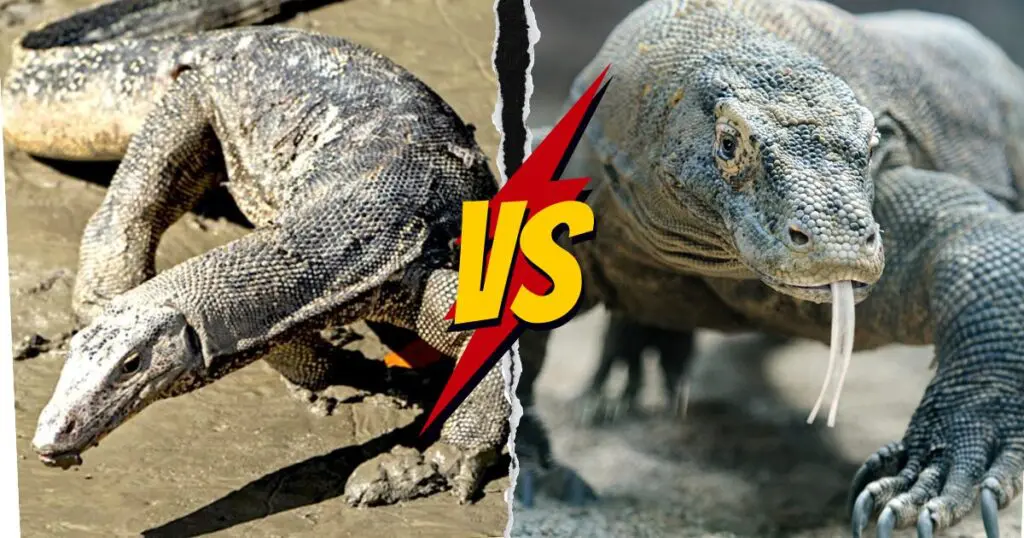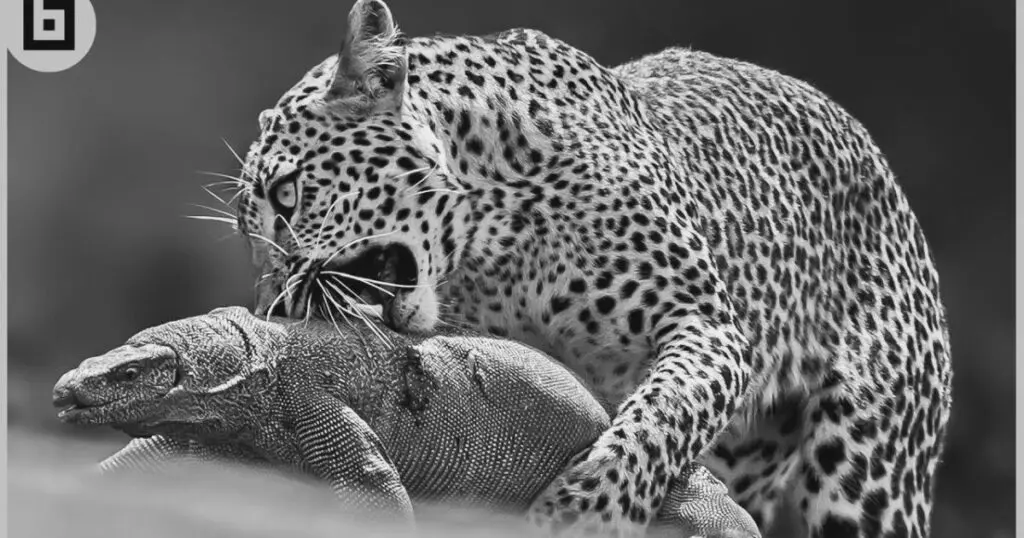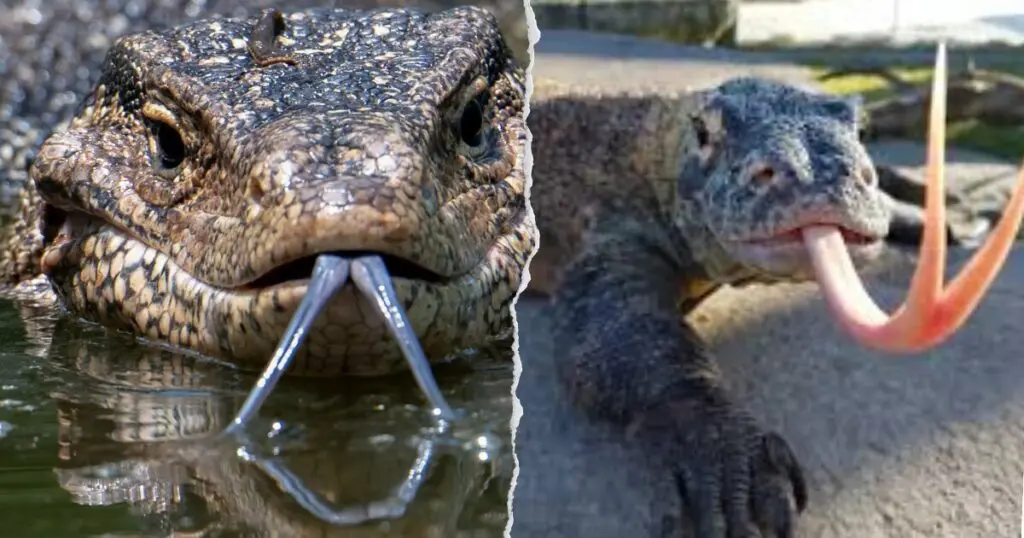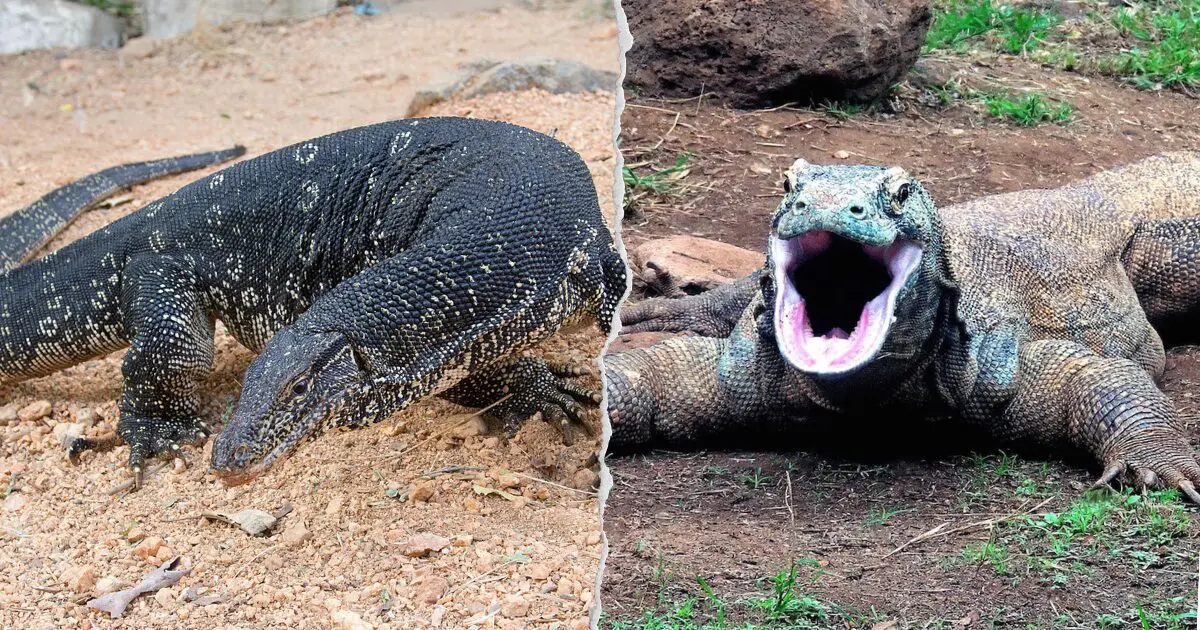It is pretty difficult to tell the difference between a Komodo dragon vs monitor lizard appearance. Both are reptiles and lizards. And, of course, both these lizards are apex predators in their respective ecosystems.
Komodo dragons are the king lizards, much bigger than most monitor lizards. Komodo dragons also pack a venomous punch, while most monitor lizards don’t. Both are impressive reptiles, but Komodo dragons win the size and venom wars.
Well, these reptiles often overlap when it comes to their habitat. Let’s find out what happens when they break up in a fight.
Key points of the article:
- There is a visual similarities between the two lizards but both have forked tongues.
- They are almost similar in different skills and abilities.
- Monitor lizard is not a specific animal but a species. Therefore, their nature can vary.
- Komodo dragon has more strength than monitor lizards, usually,
- These reptiles are very aggressive and cannot be friends.
Komodo Dragon vs Monitor Lizard: An Introduction
Let’s have a brief intro first to our two reptile animals. Since a monitor lizard is not a specific animal, some parts of it won’t be certain information.
| Criteria | Komodo Dragon | Monitor Lizard (Varies by Species) |
| Class | Reptile (Lizard) | Reptile (Lizard) |
| Scientific Name | Varanus komodoensis | Varanus spp. (over 80 species) |
| Average Height | Up to 3 meters (10 ft) at the shoulder | 1-3 meters (3-10 ft) at the shoulder |
| Average Weight | 130-180 kg (300-400 lbs) | 0.5-150 kg (1-330 lbs) |
| Origin | Indonesia (Komodo Islands) | Varies by species (Africa, Asia, Southeast Asia, Australia) |
| Temperament | Solitary, ambush predator | Varies by species (solitary, semi-social, territorial) |
| Appearance | Large, muscular body with thick scales, long forked tongue | Varies by species (long bodies, powerful tails, some with crests) |
| Hunting Weapon | Claws, teeth, venomous bite (Komodo Dragon only) | Claws, teeth, powerful jaws (venomous in some species) |
| Speed | Up to 13 mph (20 km/h) in short bursts | Varies by species (some fast runners, others ambush predators) |
| Climbing | Good climbers, especially as juveniles | Varies by species (some excellent climbers, others primarily terrestrial) |
| Swimming | Strong swimmers | Varies by species (some excellent swimmers, others prefer land) |
| Social Behavior | Solitary except for mating | Mostly solitary, some with loose social structures |
| Lifespan | Up to 30 years in captivity | 15-20 years |
| Bite Power | One of the strongest bites among reptiles (Komodo Dragon only) | Varies by species (strong bites, some venomous) |
| Intelligence | Considered intelligent for a reptile | Varies by species (some exhibit problem-solving skills) |
Read also: Komodo dragon vs Honey Badger
Komodo Dragon vs Monitor Lizard: How to Identify

At first glance, there can be some confusion. You can mistake them for each other. Anyway, since I am here, you won’t have a problem identifying them from now on.
How to Identify a Komodo Dragon?
- Enormous size: Up to 3 meters (10 ft) long
- Forked tongue: Long and snake-like
- Venomous bite: Look for a dewlap (loose skin under the chin) and serrated teeth
- Exclusive habitat: Komodo Islands in Indonesia
- Solitary behavior: Ambush predator, rarely seen with others
How to Identify a Monitor Lizard?
- Look for a long body, powerful legs, and a long tail. Some monitor lizard species have crests or spines on their back or neck.
- Monitor lizards have a long, forked tongue. Unlike the Komodo dragon, it may be shorter and fatter.
- Monitor lizards have a wide range across Africa, Asia, Southeast Asia, and Australia. The specific habitat will vary depending on the species.
- Monitor lizards can be solitary, semi-social, or territorial. Their hunting style can also vary depending on the species.
Komodo Dragon vs Monitor Lizard: Who Wins the Combat
It’s generally the Komodo dragon here who stands tall as the superior lizard. Let’s do a combat on their strengths:
Round 1: Size
The Komodo Dragon crushes this round! These giants can stretch up to a whopping 3 meters (10 ft) at the shoulder. Some of them can get even bigger! Their weight is equally impressive, tipping the scales at a hefty 300-400 lbs.
In comparison, most monitor lizards weigh significantly less. They can be tall or long in size. Some of them actually become about 3 feet long. However, they usually weigh below 10 lbs. Nonetheless, some of them can weigh as much as a Komodo dragon. Still, the average weight is higher for Komodo dragons.
So, it stands at Komodo Dragon 1:0 Monitor Lizard.
Round 2: Temperament
This round gets interesting! Here’s a breakdown of their temperaments:
- Komodo Dragon: Solitary ambush predators. They’re patient and opportunistic, waiting for prey to come close before striking. While not actively aggressive towards humans unless threatened. They can still kill and eat humans.
- Monitor Lizard: Varies greatly depending on the species. Some, like the Nile monitor, are fiercely territorial. These lizards can be aggressive towards humans if provoked. Others, like the Ackie monitor, are known for being relatively docile. Some are even kept as pets.
So, who wins? It’s a tie! We are at Komodo Dragon 1:0, Monitor Lizard!
Round 3: Hunting Weapon

This round gets bloody! Both Komodo dragons and monitor lizards are apex predators. They are both equipped with an impressive arsenal for taking down prey.
Komodo Dragon
- Claws: Razor-sharp claws for tearing flesh and grappling with prey.
- Teeth: Serrated teeth designed for inflicting deep wounds.
- Venomous Bite: Komodo dragons boast a powerful venomous bite. Their saliva contains a cocktail of toxins that can cause blood poisoning, hypothermia, and even death.
Monitor Lizard
- Claws: Similar to Komodo dragons, monitor lizards have sharp claws for gripping and slashing.
- Teeth: Powerful jaws with strong teeth for delivering a crushing bite.
- Venom: Not all monitor lizards are venomous. Some larger species, like the beaded monitor, possess venom glands in their lower jaw. This venom can cause paralysis and even death in smaller prey.
Who wins?
This round is a close call. Nonetheless, the Komodo dragon edges it out due to its unique venomous bite. While some monitor lizards also possess venom, the Komodo dragon’s venom is considered more potent.
It is now Komodo Dragon 2:0 Monitor Lizard!
Round 4: Speed
Here, things get interesting! While Komodo dragons might seem like lumbering giants, they surprise in this round.
- Komodo Dragon: They’re not marathon runners. But they can unleash surprising bursts of speed, reaching up to 20 km/h (13 mph) in short sprints. This is perfect for their ambush hunting style. It allows them to close the gap on unsuspecting prey quickly.
- Monitor Lizard: This category showcases the monitor lizard’s diversity. Some of them can reach up to 30 mph! These speedy lizards rely on outrunning prey or chasing them down in open areas.
Who wins?
This round goes to the monitor lizard! Their superior base speed and variation in running styles give them the edge.
The score is now Komodo Dragon 2:1 Monitor Lizard!
Round 5: Intelligence

The brain is also an important aspect of hand-to-hand combat. Both Komodo dragons and monitor lizards are considered intelligent reptiles.
Komodo dragons strategize hunts, remember food sources, and even use tools.
Similarly, monitor lizards exhibit a range of cognitive abilities depending on the species. Some excel at problem-solving, others work together to take down prey, and many display curiosity.
It’s a close call. They both showcase a level of intelligence that allows them to dominate their environment. So, it’s a tie!
The score is still Komodo Dragon 2:1 Monitor Lizard!
Round 6: Special Abilities
This round highlights the diverse physical prowess of these reptiles.
- Swimming: Komodo dragons are surprisingly strong swimmers. They use their powerful tails and webbed feet to propel. Some monitor lizards are excellent swimmers as well.
- Climbing: Komodo dragons are decent climbers, even juveniles. However, they become less agile as adults. Monitor lizards, on the other hand, excel in this category. Their sharp claws and flexible bodies allow them to navigate trees and rocky terrain with ease.
- Jumping: Neither Komodo dragons nor most monitor lizards are known for impressive jumping abilities. Their size and body structure are better suited for grappling on the ground.
Who wins? This round is another tie. The score is still Komodo Dragon 2:1 Monitor Lizard!
Round 7: Strength
Komodo dragons flex their muscles in this round! Their sheer size translates to incredible physical power. Their powerful jaws can crush bone, and their sharp claws can tear flesh. While some monitor lizards are quite strong, they can’t match the raw power of a Komodo dragon.
Now, it stands at Komodo dragons 3:1 Monitor lizard. Komodo Dragon wins! Their immense size and muscular build give them a clear advantage in brute strength.
Komodo Dragon and Monitor Lizard: Can They Be Pet?
Why would you want to keep such aggressive pets? Want to keep an exotic pet? Bearded dragons make good pets, in that case.
- Komodo Dragons: A resounding no! These giant, venomous lizards are wild animals with powerful instincts. Keeping one as a pet is incredibly dangerous. Additionally, having them as pets is illegal as well.
- Monitor Lizards: Here, it depends on the species. Some smaller monitor lizards with calm temperaments. Ackie monitor, for example, can be kept by experienced reptile enthusiasts with proper permits and enclosures. However, most monitor lizards are not suitable pets.
Komodo Dragon vs Monitor Lizard: Can They Be Friends?
No, they cannot be friends. Yes, they are lizards but not friends. Just like we humans are not friends with grizzly bears.
Both Komodo dragons and monitor lizards are solitary animals. They do not want to be friends with other animals. Besides, they have predatory instincts. Therefore, they may start fighting at first sight.
Also, reptiles lack the complex social behaviors seen in mammals. They wouldn’t form the kind of bonds we associate with friendship.
Conclusion
Let’s not drag this Komodo dragon vs monitor lizard discussion anymore. Both are lizards, yet there are so many differences. They can even fight with each other over food. However, monitor lizards usually tend to avoid the fight unless they are of the same size. Anyway, it is Komodo dragons who stand as the apex predator between the two.
